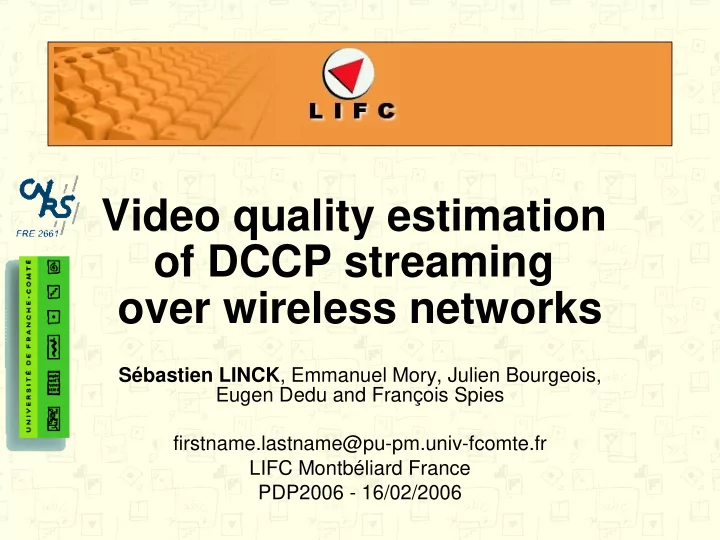

Video quality estimation of DCCP streaming over wireless networks Sébastien LINCK , Emmanuel Mory, Julien Bourgeois, Eugen Dedu and François Spies firstname.lastname@pu-pm.univ-fcomte.fr LIFC Montbéliard France PDP2006 - 16/02/2006
Introduction Two modes of video visualization on Internet Downloading then playing Streaming Many streaming solutions developed, but always RTP/UDP-based and without any real congestion control Our objectives Streaming with congestion control Validate our method by simulation Compare final quality between various solutions of streaming 16/02/2006 PDP 2006 - Montbéliard 2/22
Plan Problematics Context Environment of simulation Case study Conclusion and future work 16/02/2006 PDP 2006 - Montbéliard 3/22
Plan Problematics Context Environment of simulation Case study Conclusion and future work 16/02/2006 PDP 2006 - Montbéliard 4/22
Problematics Mobile client Heterogeneous mobile terminals Wireless technologies with various bandwidths Transport layer : congestion control Bandwidth estimation Losses management over wireless networks Wireless MAC layer Interferences management + other particularities => Adaptation of multimedia flow according to the terminal and the network 16/02/2006 PDP 2006 - Montbéliard 5/22
Plan Problematics Context Environment of simulation Case study Conclusion and future work 16/02/2006 PDP 2006 - Montbéliard 6/22
Context (1/3) Application layer Standard RTP/RTCP RTCP gives only losses informations Mixer Software component Intercalated between the server and the client Goal: adaptation of quality (different resolutions, coding, ...) 16/02/2006 PDP 2006 - Montbéliard 7/22
Context (2/3) Transport layer: new protocol DCCP ( Datagram Congestion Control Protocol ) UDP combined with congestion control (CC) Separation transport / congestion control 2 CC implemented: • TCP-like: like TCP! • TFRC TFRC ( TCP-Friendly Rate Control ) Equation-based congestion control Smoother adaptation of the throughput 16/02/2006 PDP 2006 - Montbéliard 8/22
Context (3/3) MAC layer Wireless network: 802.11 ARQ (Automatic Repeat reQuest) • MAC layer acknowledgements • After N attempts, a packet is no longer retransmitted and is removed Interferences are • Independent • Temporary • But Frequent Retransmissions => time loss 16/02/2006 PDP 2006 - Montbéliard 9/22
Plan Problematics Context Environment of simulation Case study Conclusion and future work 16/02/2006 PDP 2006 - Montbéliard 10/22
Environment (1/3) Our Video On Demand Simulation Architecture Simulated transfer of real data Real video data Simulation Environment Network Simulator (NS2) Mobile DCCP DCCP Client Access point Wireless network Mixer (802.11b/g) 16/02/2006 PDP 2006 - Montbéliard 11/22
Environment (2/3) Wireless network 802.11 Interferences => MAC retransmissions Retransmissions => RTT ( Round Trip Time ) increase For a transport protocol, generally: RTT increase = congestion => throughput decrease Our solution, for each packet, the wireless card: Sums the "time lost" Inserts it in a new optional field of DCCP header New calculation method of RTT => optimal throughput 16/02/2006 PDP 2006 - Montbéliard 12/22
Environment (3/3) Our NS2 contributions Mixer integration • New RTP module – Transport protocol switching – Real video utilization • Adaptation module Creation of a cross-layer module which transmits the DCCP estimated bandwidth from transport to application layer Correction of TFRC wireless implementation 16/02/2006 PDP 2006 - Montbéliard 13/22
Plan Problematics Context Environment of simulation Case study Conclusion and future work 16/02/2006 PDP 2006 - Montbéliard 14/22
Case study (1/5) Scenario 16/02/2006 PDP 2006 - Montbéliard 15/22
Case study (2/5) Results Comparison available bandwidth / bandwidth estimated by DCCP 16/02/2006 PDP 2006 - Montbéliard 16/22
Case study (3/5) Results Packets losses 16/02/2006 PDP 2006 - Montbéliard 17/22
Case study (4/5) Results PSNR (Peak Signal to Noise Ratio) = quality 16/02/2006 PDP 2006 - Montbéliard 18/22
Case study (5/5) Conclusion on the results Adaptation necessary in wireless networks DCCP/TFRC is a valid transport solution for RTP Taking into account of the MAC retransmissions • Improvement of the video rendering quality during interference stage • Optimal use of the bandwidth in the event of multiple interferences 16/02/2006 PDP 2006 - Montbéliard 19/22
Plan Problematics Context Environment of simulation Case study Conclusion and future work 16/02/2006 PDP 2006 - Montbéliard 20/22
Conclusion – Future work Presentation of a complete DCCP streaming simulation environment RTP/DCCP Better quality due to more accurate network information from DCCP Taking into account of MAC retransmissions => benefit Future work Simulations on a large scale Low power consumption 16/02/2006 PDP 2006 - Montbéliard 21/22
Questions ? 16/02/2006 PDP 2006 - Montbéliard 22/22
Recommend
More recommend